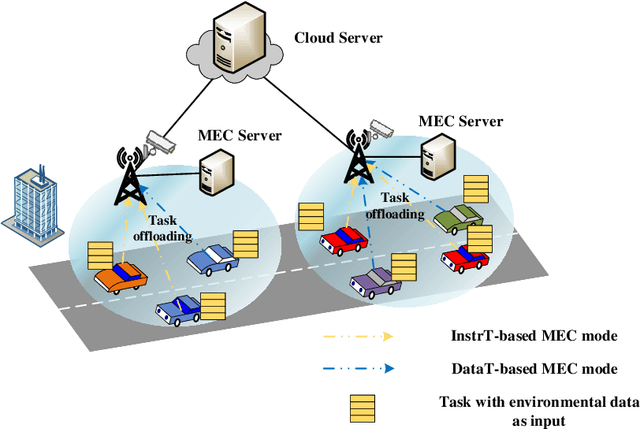Yilong Hui
Structural Knowledge-Driven Meta-Learning for Task Offloading in Vehicular Networks with Integrated Communications, Sensing and Computing
Feb 25, 2024



Abstract:Task offloading is a potential solution to satisfy the strict requirements of computation-intensive and latency-sensitive vehicular applications due to the limited onboard computing resources. However, the overwhelming upload traffic may lead to unacceptable uploading time. To tackle this issue, for tasks taking environmental data as input, the data perceived by roadside units (RSU) equipped with several sensors can be directly exploited for computation, resulting in a novel task offloading paradigm with integrated communications, sensing and computing (I-CSC). With this paradigm, vehicles can select to upload their sensed data to RSUs or transmit computing instructions to RSUs during the offloading. By optimizing the computation mode and network resources, in this paper, we investigate an I-CSC-based task offloading problem to reduce the cost caused by resource consumption while guaranteeing the latency of each task. Although this non-convex problem can be handled by the alternating minimization (AM) algorithm that alternatively minimizes the divided four sub-problems, it leads to high computational complexity and local optimal solution. To tackle this challenge, we propose a creative structural knowledge-driven meta-learning (SKDML) method, involving both the model-based AM algorithm and neural networks. Specifically, borrowing the iterative structure of the AM algorithm, also referred to as structural knowledge, the proposed SKDML adopts long short-term memory (LSTM) network-based meta-learning to learn an adaptive optimizer for updating variables in each sub-problem, instead of the handcrafted counterpart in the AM algorithm.
Scalable Resource Management for Dynamic MEC: An Unsupervised Link-Output Graph Neural Network Approach
Jun 20, 2023



Abstract:Deep learning has been successfully adopted in mobile edge computing (MEC) to optimize task offloading and resource allocation. However, the dynamics of edge networks raise two challenges in neural network (NN)-based optimization methods: low scalability and high training costs. Although conventional node-output graph neural networks (GNN) can extract features of edge nodes when the network scales, they fail to handle a new scalability issue whereas the dimension of the decision space may change as the network scales. To address the issue, in this paper, a novel link-output GNN (LOGNN)-based resource management approach is proposed to flexibly optimize the resource allocation in MEC for an arbitrary number of edge nodes with extremely low algorithm inference delay. Moreover, a label-free unsupervised method is applied to train the LOGNN efficiently, where the gradient of edge tasks processing delay with respect to the LOGNN parameters is derived explicitly. In addition, a theoretical analysis of the scalability of the node-output GNN and link-output GNN is performed. Simulation results show that the proposed LOGNN can efficiently optimize the MEC resource allocation problem in a scalable way, with an arbitrary number of servers and users. In addition, the proposed unsupervised training method has better convergence performance and speed than supervised learning and reinforcement learning-based training methods. The code is available at \url{https://github.com/UNIC-Lab/LOGNN}.
Green Interference Based Symbiotic Security in Integrated Satellite-terrestrial Communications
Jun 06, 2022



Abstract:In this paper, we investigate secure transmissions in integrated satellite-terrestrial communications and the green interference based symbiotic security scheme is proposed. Particularly, the co-channel interference induced by the spectrum sharing between satellite and terrestrial networks and the inter-beam interference due to frequency reuse among satellite multi-beam serve as the green interference to assist the symbiotic secure transmission, where the secure transmissions of both satellite and terrestrial links are guaranteed simultaneously. Specifically, to realize the symbiotic security, we formulate a problem to maximize the sum secrecy rate of satellite users by cooperatively beamforming optimizing and a constraint of secrecy rate of each terrestrial user is guaranteed. Since the formulated problem is non-convex and intractable, the Taylor expansion and semi-definite relaxation (SDR) are adopted to further reformulate this problem, and the successive convex approximation (SCA) algorithm is designed to solve it. Finally, the tightness of the relaxation is proved. In addition, numerical results verify the efficiency of our proposed approach.
 Add to Chrome
Add to Chrome Add to Firefox
Add to Firefox Add to Edge
Add to Edge